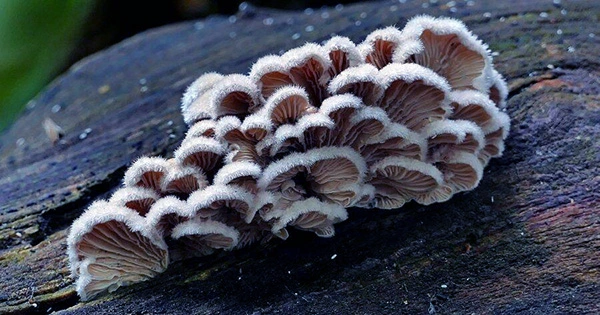The mycelium network is a way for mushrooms and other fungi to interact electrically. New study finds distinctions across species, which are characterized as having their own languages, generated by trains of voltage spikes, with each “language” consisting of roughly 50 trains, or words. The neurons in our brains communicate through changes in electrical potential, but “nearly all animals without a nervous system create spikes of electrical potential,” according to the article published in Royal Society Open Science.
These can take the shape of spike clusters called as trains, which people can detect with detectors within or outside their cells. The network’s threads, known as hyphae, may connect fungus underground across great distances, potentially transforming entire ecosystems into an Avatar-like superorganism. Professor Andrew Adamatzky previously observed that oyster fungus exhibit spikes of two lengths, ranging from 2.6 minutes to 14 minutes. That’s all you need for a digital language, even if it makes Entish appear rushed. “This shows a potential that mycelium networks modify information via interaction of spikes and trains of spikes in a way similar to neurons,” Adamatzky said in his latest research.

Adamatzky has previously demonstrated that the trains alter when handled, exposed to light, or when their surroundings undergoes chemical changes. Others have discovered that there is possible communication between fungi and plants, rather than just fungus to fungus. The signals are assumed to transmit the finding of abundant food supplies or dangers, as well as contribute to trading networks. Adamatzky studied four fungus species to determine if they speak the same “language” for the current study. Each of the ones he examined turned out to be rather different – one had large pauses between spikes, while another had a wider range of “words” made up of diverse combinations of high- and low-frequency pulses.
To start the process of translating at least one fungal “language” into English, Adamatzky sought for recordings of trains that were sufficiently identical that they might be mistaken for the same “word” being spoken several times. This is a significant difficulty. Even new human languages perplex us as we try to figure out if two identical sounds reflect the same word spoken somewhat differently or words with completely distinct meanings. It must be considerably more difficult to distinguish “words” in mushroom. Fortunately, linguists have created a plethora of word analysis software. Using some of these, Adamatzky was able to recognize specific trains that were repeated frequently and in a similar manner, indicating that they were most likely “words.”
He also discovered that the distribution of spike train lengths corresponds to the lengths of words in human languages. Some species, like humans, utilize longer “words” than others, with Cordyceps militaris using an average of 8.9 spikes per “word” compared to Omphalotus nidiformis’ 3.3. In comparison, a word in English contains 4.8 letters, whereas a word in Russian has six.
Adamatzky discovered that some of the species studied have vocabularies of 50 “words,” however none of them utilize more than 15-20 of them frequently. Schizophyllum commune, sometimes known as “split gills,” has the most complicated “sentences” of the four species analyzed, but with thousands of fungi remaining to be tested, Adamatzky is unlikely to find the most sophisticated species right soon. “Though interesting, the interpretation as language seems perhaps overenthusiastic,” Dr. Dan Bebber of the University of Exeter told The Guardian, “and would require significantly more research and testing of important ideas before we see ‘Fungus’ on Google Translate.”
Whether or not his findings with mushrooms are correct, Adamatzky is already putting them to use. The University of the West of England in Bristol, where he works, is creating a new building with built-in fungus sensors. The fungi will react to changes in light, temperature, and pollution, and the structure will be able to adjust as well, ensuring that the interior is better suited to its human residents. “The building will manage gadgets based on environmental circumstances, acting as a massively parallel computer,” Adamatzky said in a statement when the project was launched. Biological sensors will conserve energy that would otherwise be used to construct, operate, and recycle detectors in other smart buildings.
















